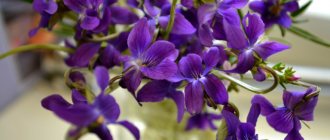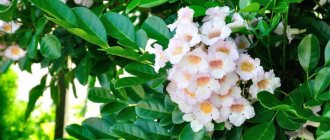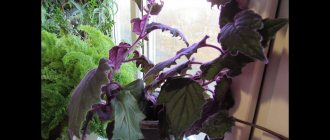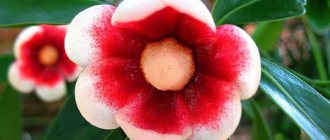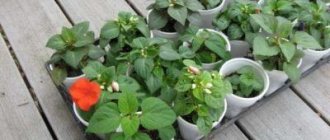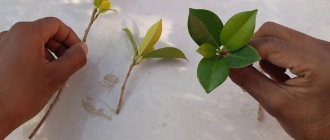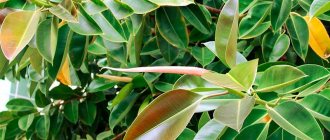Fatsia (Fatsia) or aralia is a dicotyledonous evergreen plant from the Araliaceae family. It comes from Japan, and in the wild it is distributed in Korea, New Zealand, and Taiwan, where it can reach a height of 5 m. Until the mid-19th century, the name “Fatsia” did not exist. The only representative of the genus that was brought to Europe from Japan was called Aralia japonica. In 1854, botanists separated this plant into a separate genus, which they called Fatsia. It includes only 3 types. It differs from other representatives of the Araliaceae in the structure of its leaves and inflorescence, and also in the fact that it is evergreen and not deciduous.
Fatsia has been grown in indoor floriculture for about 200 years. It is loved by many for its large variegated leaves and relative ease of care. Although today it is inferior in popularity to more exotic representatives of the tropics, it has a number of advantages. Aralia grows quickly, does not require constant high humidity and can tolerate light deficiency. If you create suitable conditions, after 2 years you can get a plant about 1 m high, which can be used to green any interior.
Types and varieties for growing at home
The genus is represented by only 3 species. For indoor growing, Fatsia japonica is mainly used. This shrub grows up to 1.5 m in height. The trunk is weakly branched, the leaves are petiolate, up to 30 cm in volume, with broadly lanceolate lobes. Depending on the shape, the leaves may have a different shade of border. The flowers are small, white or light green.
Based on this species, varieties have been bred that are used for home cultivation. Most Popular:
- Aurea marginatis;
- Moseri;
- Spider's Web;
- Murakumo Nishik;
- Variegata.
Fatshedera Lizei
This hybrid is the result of crossing Fatsia japonica and common ivy, which was randomly bred in 1912 in France. This is an evergreen shrub, reaching a height of more than 3 m. The leaves are shiny, no more than 18 cm long. Can be grown as a climbing plant or placed as a support. Unlike Fatsia, whose leaves have 7 lobes, Fatshedera has 5; they resemble maple leaves in shape.
A little history
The plant has many poetic names , such as “house” or “Japanese chestnut”. Its leaves are really similar to chestnut leaves, only smaller and more graceful in shape. The main name “japonica” (“Japanese fatsia”) and its derivatives “samurai fatsia” or “Japanese Empire fatsia” (plant seeds are often sold under this name) appeared only in the second half of the 19th century.
Until this time, the tree brought from Japan to Europe had a different name - “Japanese Aralia”. And only in 1854, botanists isolated a separate genus Fatsia from the Araliaceae family, which included 3 plant species that differed from the rest in the structure of leaves and inflorescences, as well as the ability to remain green all year round.
Home care
It is believed that Fatsia is easy to care for. It is able to adapt to various conditions and is generally hardy. But in order to avoid problems when growing, you still need to learn some rules of shrub agricultural technology.
Location and lighting
It is worth considering that the plant grows quickly and will eventually take up quite a lot of space. Therefore, a small room is unlikely to be suitable for it. The culture looks impressive in large halls, offices, and spacious rooms. The main thing is that she has a lot of space with an optimal microclimate.
Fatsia is not particularly picky about lighting. It can develop normally both in partial shade and in a bright place. But varieties with variegated foliage require more lighting. If it is deficient, the leaves will become monochromatic. Also in the shade, shoot growth becomes slower. Therefore, the best option for growing shrubs is the western or eastern side of the room. In summer, you can take the flowerpot outside, but shade it from the scorching rays of the sun.
Soil and drainage
Like other representatives of the Araliaceae, Fatsia prefers neutral or slightly acidic soils. It can also grow in hydroponics. The main thing is that the substrate allows air and moisture to pass through well.
You can prepare the soil for the flower yourself from:
- turf (2);
- sand (1);
- humus (1);
- peat (1).
Choosing a pot
The container for young plants can be anything.
The main thing is that it is deep enough and that the root system fits freely in it. But there should not be too much free space so that the soil does not turn sour. Each time when replanting, take a pot 3-4 cm larger than the previous one. On a note! For adult fatsia, it is preferable to take a ceramic container. It is heavier and a plant with a powerful crown will not topple it. There must be drainage holes at the bottom. The drainage layer (expanded clay, pebbles) should occupy about 1/3 of the height of the pot.
Planting and transplanting
Young plants need to change the pot annually. They grow out of an old container quite quickly. For adult specimens, transplantation is carried out as needed, when the roots begin to emerge from the drainage holes. It is better to do this in spring or early summer. Before transplanting, you need to disinfect the soil and pot.
Carrying out the procedure:
- Place a layer of drainage on the bottom.
- Carefully remove the culture from the old pot without disturbing the earthen ball.
- Remove rotten and damaged roots.
- Place the fatsia in the center of the new container. If necessary, install the support immediately.
- Sprinkle with soil, lightly compact it, and water.
- Place in a permanent place and spray regularly. This will help the plant adapt faster.
Visual step-by-step video - instructions for transplanting Fatsia:
Temperature
From spring to autumn, it is better to keep fatsia at a temperature of +18..22°C. It can also survive wintering at room temperature and only if additional illumination is provided with a fluorescent lamp. But it is preferable to move it to a cool room at +10..15°C. For variegated forms, the temperature should not be lower than +16°C throughout the year.
Humidity and watering
One of the main conditions for the normal development of aralia is ensuring proper watering. It is important that it be regular. The plant does not tolerate either drying out of the earthen coma or overwatering. In summer, you need to moisten the soil immediately after its top layer dries. In autumn, the amount of watering is gradually reduced. If Fatsia overwinters in a cool room, then watering should be very sparse. But make sure that the soil does not dry out completely.
Note! As a representative of the tropics, Fatsia prefers high humidity. To increase it, it is recommended to regularly spray or wipe the leaves with a damp sponge. From time to time you can give the shrub a warm shower, but first cover the soil with film so as not to wet it. In winter, the lower the temperature of the flower, the lower the humidity required. Sometimes you can wipe the leaves from dust with soft, settled water.
Feeding and fertilizers
In the spring-summer period, Aralia is fed once every 10-14 days. Liquid mineral fertilizers for deciduous crops are suitable for it. It is recommended to apply them along with watering. They are periodically alternated with organic matter. In winter, feeding is stopped.
Bloom
Fatsia gained popularity thanks to its beautiful foliage. In indoor conditions, flowering is a very rare occurrence. In nature, it blooms from late October to December. The flowers are creamy white, collected in racemes, have 5 petals and long stamens.
Trimming and support
To give the crop a more luxuriant shape, it is recommended to pinch the tops of the shoots at a young age. Excess shoots are also pruned so that Fatsia can branch better. Every spring, sanitary pruning is performed, removing weak stems that have lost their decorative properties.
Due to the weight of the crown, a thin trunk may not withstand the load. Therefore, it is recommended to install a support when planting. Without it, the plant may grow crooked and this situation will be impossible to correct. If the stem begins to deviate from the straight axis, you need to tie it to a support (you can use bamboo sticks). The structure must be stable and not interfere with leaf growth.
General characteristics of fatsia
This is a woody plant with large leaves. Their width can sometimes reach 40 cm. The fatsia leaf is very original and beautiful due to its shape in the form of an open five, and has a glossy, bright green color. The height of this representative of the flora in natural conditions is about 4 meters. Indoor flowers require a lot of free space, free arrangement, and only if these conditions are met can they delight you with a chic crown.
The plant belongs to the Araliaceae family and has a single pure species called Japanese fatsia, as well as several varieties (see their names and photos at the end of the article).
Reproduction methods
There are several ways to propagate fatsia.
From seeds
The procedure is best carried out in March. Take fresh seeds for planting. To check germination, fill them with water. Those that surface are rejected. Only seeds that have fallen to the bottom are suitable for sowing.
Pour peat-sand mixture into the planting container. Plant the seeds to a depth of 1 cm, cover with film. Place the crops for germination in a room with a temperature of about +18..25°C. After the formation of 2 true leaves, the seedlings can be planted in separate pots, 1 each. Grow in a warm, bright place, but out of direct sun.
Cuttings
Cuttings are harvested in the spring, before the awakening begins. Cut the apical shoots with 2-3 buds. Treat them with a root formation stimulator (Epin, Kornevin). Plant the cuttings in a peat-sand substrate. Cover the top with polyethylene to create a greenhouse effect. Root at a temperature of +20..26°C. From time to time, ventilate the greenhouse and moisten the substrate. When the roots appear, plant the cuttings in separate pots.
By layering
This method is suitable if the trunk is too extended at the top and becomes bare. In the spring, make a circular cut on it. Wrap it in sphagnum moss moistened with Kornevin. Wrap the structure in polyethylene. Keep the moss moist at all times. The roots around the incision site will appear in 1-1.5 months. They need to be allowed to get stronger for another month. After this, trim the trunk just below the new roots. Plant the cuttings in a new pot.
Fatsia cuttings
- Propagation by cuttings is carried out in the spring. Rooting at a temperature of 24-26 degrees in moist soil with diffused light occurs very quickly;
- Cuttings 10 cm tall should acquire a certain number of buds that are ready to grow;
- Cover them with a glass jar or film, and plant them in the ground a month after rooting. With this method, voluminous but small shrubs are formed.
Features of seasonal care
Like many ornamental plants, Fatsia prefers to rest in winter. With the onset of cold weather, all life processes slow down and new shoots practically do not appear. Therefore, caring for the crop requires some correction.
Fertilizers are completely stopped in the fall, and watering is significantly reduced. But you can’t completely dry out the soil. It is preferable to place the flowerpot in a cool place. But for variegated forms, the temperature should not fall below +16 degrees. If the fatsia continues to overwinter in the warmth, then it must be sprayed periodically and additional lighting must be provided with fluorescent or LED lamps.
Care errors and their elimination
The most common problems when growing Fatsia and their elimination:
| Problem | Causes | Solution |
| Soft and drooping leaves | Dry or waterlogged soil | Adjust the watering regime |
| Drying of tips, wrinkling of leaves | Dry indoor air | Spray the plant more often, take a warm shower |
| Slowing or stopping growth | cramped potty | Transplant fatsia into a larger container |
| Variegated leaves become monochromatic | Lack of lighting | Move the flowerpot to a brighter place |
Diseases and pests, control methods
Indoor fatsia has stable immunity. But with excess moisture and in the cold, it can develop gray rot. The lower part of the stem is covered with a gray fluffy coating. Over time, the plant dies. To save it, it is necessary to remove all affected parts, treat it with a fungicide and regulate the conditions of detention.
Fatsia pests:
- red spider mite;
- thrips;
- aphid;
- whitefly
Insects parasitize on both sides of the leaves, as a result of which they turn yellow, curl and crumble. To get rid of insects, you first need to wash the plant in the shower. When it dries, treat with an insecticide (Aklelic, Karbofos, Aktara and others).
